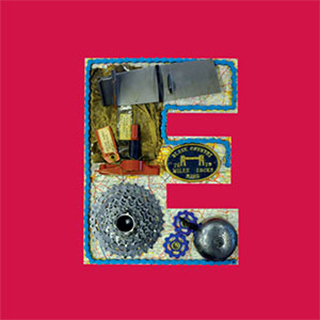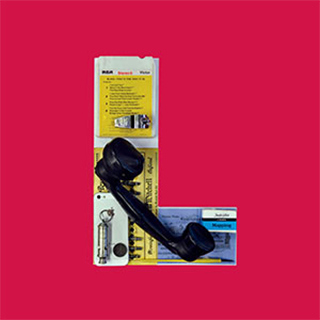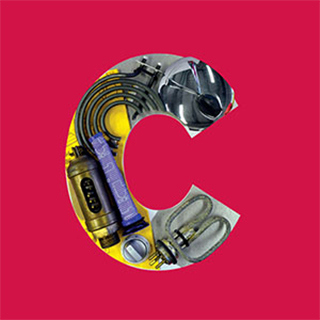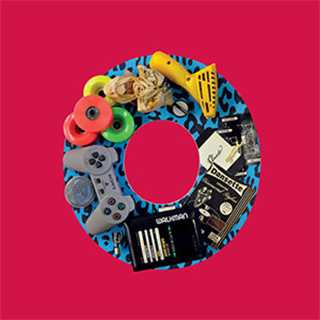The items showcased in the WELCOME display of our reception celebrate many of these remarkable innovations and the incredible engineers behind them.
Automotive
The West Midlands has a rich heritage of automotive invention and manufacturing.
- Austin A30 orange glass indicator lenses
- Austin/ Mini radiator fan
- Austin A40 Sports GD2 Series (1950-53) carb fuel inlet brass mesh filter
- Austin Rover MG Maestro 1600 R Series 1.6 (1983-84) head gasket
- Rover 45/400 (1995-05) boot badge
- Austin Morris Rover
- Bakelite gearstick knob
- Mini CZH 1305 bonnet badge - Herbert Austin started his car company based in Longbridge in 1905. After surviving the wars, The Austin Motor Company merged with long-term rival Morris Motors, becoming The British Motor Corporation and later transitioning through British Leyland and the Austin Rover Group. On its introduction in 1959, the Mini was marketed as the Austin Seven and Morris Mini-Minor until it became a marque in its own right in 1969. 50 years on all Prince four-cylinder petrol engines for Mini (and BMW) are produced at the Hams Hall Plant.
- Windscreen wiper arm - Birmingham manufacturer Mills Munitions patented a windscreen wiper design in 1921.
- Britax vintage car seatbelt buckle - The seatbelt was first invented in the mid-19th century by English engineer George Cayley to use on his glider. Britax began manufacturing automotive safety equipment in the UK in 1938 and continue today.
- Honda Civic MK8 (2006-11) engine ignition push button - Introduced an electric push-button starter in 1912, though the latest push-start ignitions appeared in the early 2000s.
- Toyota Prius Hybrid Synergy Drive boot badge - Dr Ferdinand Porsche conceived the concept of powering a car using both electricity and petrol in 1898. The first mass-produced hybrid car, the Toyota Prius, was introduced in 1997.
- Lucas 12-volt windtone ‘snail’ horn - Joseph Lucas’s Birmingham components manufacturing firm made an electric car horn in 1910 that became the industry standard.
- Selection of standard and mini blade fuses.
Transport
With its busy airport, famous waterways, road and rail networks, Birmingham has long been a major transport hub.
- Titanium RAF Panavia Tornado aircraft RB199 engine intake blade - Built in the UK for the Cold War, the RB199 is a modular engine designed to improve service and give the Tornado outstanding performance. It has amassed over 5 million flight hours since entering service.
- Single-speed bike chain - In 1880, young Swiss/British engineer Hans Renold achieved a significant technical breakthrough when he patented the bush roller chain. This innovative chain technology solved many problems inherent in existing solutions bringing a new level of performance to the transmission of mechanical power.
- 8-speed bike gear cassette - In 1895 Frenchman Jean Loubeyre patented a device for derailing the chain from one sprocket to another. He called it the Polyceler (multispeed). Today, a typical bike gear cassette can have anything between five and 12 sprockets.
- Ceramic bike bearing jockey wheel pulley - The first patent for a radial style ball bearing was awarded to Jules Suriray, a Parisian bicycle mechanic, on 3 August 1869.
- WW2 Rolls Royce Spitfire/Lancaster Motor arm 37A/15351 - The Supermarine Spitfire is a British single-seat fighter aircraft used by the Royal Air Force and other Allied countries before, during, and after World War II.
- Black Country mile lock bridge plaque - The Black County Ring is made up of a combination of canals around Birmingham. The Staffordshire and Worcestershire canal skirted around the edges of Birmingham and was originally designed in the 18th century by James Brindley who pioneered many of the engineering features that became common to British canals today. During the industrial revolution, Thomas Telford modified the design, and his improvements saw the new mainline cut the distance between Birmingham and Wolverhampton by several miles.
- Joseph Lucas bicycle bell - Joseph Lucas & Son was a Birmingham manufacturer of the bicycle bell. The first bicycle bell was invented by Birmingham-based inventor John Richard Dedicoat, with patents appearing as early as 1877. He went on to become a bicycle manufacturer, producing the ‘Pegasus’ bicycle.
Communication
From the first steel pen nib to the invention of the whistle, Birmingham has helped the world stay connected.
- 8 track cassette tape – Elvis, ‘That’s the way it is’ - In 1962, Philips invented the compact cassette tape for audio storage, introducing it in Europe in 1963 at the Berlin Radio Show, and in the United States in 1964, with the trademark name Compact Cassette.
- Emca city whistle & Acme thunder whistles - Around 1875, Joseph Hudson made the first whistle in a workshop at the side of his end-terrace home in St Mark’s Square, Birmingham. J. Hudson and Co. (Whistles) Ltd still exist and are based in Barr Street, Birmingham.
- William Mitchell quill pen nibs - In Newhall Street, Birmingham, John Mitchell pioneered mass production of steel pens. Mitchell’s are credited as being the first manufacturers to use machines to cut pen nibs, greatly speeding up the process.
- 1907 billhead for Joseph Gillot & Sons
- Joseph Gillot 6 x mapping dip pens set with holder - In 1831 Joseph Gillot patented a process for placing elongated points on the nibs of pens. Subsequently, Gillot devised improved modes for many of the manufacturing processes necessary to give pens the required flexibility to enable them to compete with the quill pen.
- Apple iPhone 5 - On 7 March 1876, Alexander Graham Bell was granted his patent for the telephone, and by 1891 the first overseas call was made. Since then, telephones have had major advances and on 9 January 2007, Steven Jobs unveiled the first iPhone. It combined a phone, music player and an internet device into one.
- George III farthing 1799: Soho Mint - Birmingham Mint, founded by Ralph Heaton II in 1850, worked in harmony with the Royal Mint. As a result of winning a French contract, Heaton pioneered bronze minting. The Royal Mint became so busy with their production, they had to draft in the services of The Birmingham Mint, classified as the largest private Mint in existence.
- Bakelite handset receiver - The Bakelite phone officially known as Ericsson DBH 1001, was a Swedish line of telephones made from the polymer Bakelite and produced for over thirty years between 1931 and 1962.
Home
Homes around the country would not function the same were it not for some of the essential household inventions born out of Birmingham.
- Swan kettle lid and heating resistor - Arthur L. Large, an engineer at Birmingham firm Bulpitt & Sons, invented the immersed heating resistor in 1922, bringing in the era of plug-in kettles. In 1930 the safety valve was invented by the same company. Bulpitt & Sons are known today as the Swan brand, which was acquired in 1988.
- Microwave oven mica plates - The microwave oven owes its existence to the development of the cavity magnetron at the University of Birmingham during the Second World War. Just over a month after the war ended, Percy Spencer patented the microwave oven on October 8, 1945.
- Brass pressure safety valve - Denis Papin is credited by many sources as the originator of the first pressure relief valve (circa 1679) to prevent overpressure of his steam-powered ‘digester’.
- Ring element 2000W
- Hotpoint cooker temperature control dial - In 1820, the Birmingham joiner John Heard was awarded a patent for a standalone cooking range or stove that was capable of roasting, boiling and baking – as well as heating the room it was in.
- Hoover cleaner bag
- Dyson washable filter - The first motor-driven vacuum cleaner was invented by Gloucester engineer Hubert Cecil Booth in London in 1901. Powered by oil and later by electricity, it was not practical for household use and instead was hired to clean shops, theatres, barracks and churches. It wasn’t until 1905 that the idea was revolutionised in Birmingham when Walter Griffiths of 72, Conybere Street, Highgate, built the first portable vacuum cleaner intended as a domestic appliance, patenting it as ‘Griffiths’ Improved Vacuum Apparatus for Removing Dust from Carpets’.
Play
From playing records and board games to skateboarding – Birmingham is a city that has helped make playtime so much more fun.
- Quad roller skates
- Skateboard grip-tape
- Roller ceramic bearing - In 1877, Birmingham toolmakers William Brown and Joseph Henry Hughes patented their new Aeolus design for skate wheels that had a ring of ball bearings in the middle.
- Classic Scalextric controller - Scalextric was launched at the 1957 Harrogate International Toy Fair. Its inventor, Bertram ‘Fred’ Francis adapted his clockwork Scalex cars so that they could run on a slotted rubber track using an electric motor.
- Wem Mellotron bulgin knob - Frank, Norman and Les Bradley of Birmingham tape engineering company Bradmatic invented the Mellotron, a keyboard that was arguably the original sampler.
- Cluedo spanner and playing cards - Anthony Pratt recreated murder-mystery parlour games in miniature as a board game called Murder! (later Cluedo). The long-time Birmingham resident invented the suspects and weapons between 1943 and 1945, to pass the long nights stuck indoors during air-raid blackouts.
- Dansette turnover cartridge mount - In 1932, Daniel McLean McDonald founded the company Birmingham Sound Reproducers, later known as BSR McDonald. They made their own player that could change between the various settings automatically.
- Sony Walkman - The first of Sony’s iconic portable cassette tape players went on sale on, 1st July 1979 for £120. Over 400 million Walkman portable music players have been sold.
- PlayStation 1 joypad controller - The PlayStation 1 controller was the first gamepad released by Sony Computer Entertainment in 1994.
- Microphone grill head - Birmingham born inventor Michael Gerzon teamed up with Peter Craven to invent the SoundField microphone in 1975. It could record in mono, stereo or multi-channel surround sound formats.
- - The coronation of George VI and Elizabeth as King and Queen of the United Kingdom and the Dominions of the British Commonwealth took place at Westminster Abbey, London, on 12 May 1937. The bunting was later stored in Birmingham at Austin Court.
Photography
Cameras have been manufactured in Birmingham since 1880, with well-known box camera producers The Coronet Camera Company setting up business in the city in 1926.
- Kodak tin film canister pre-1974 - These small tins were used to keep film reel from Kodak cameras. By 1974 the tins were changed to plastic canisters.
- Coronet 020 box camera - Coronet was a company founded in 1926 and produced low budget, eye-catching cameras based in Birmingham. Many of the cameras were made of cardboard including the 020 Box Camera. The original building still stands on Summer Lane.
- Conway camera colour filter model - Created by Standard Cameras, who had links to Coronet and were also based in Birmingham, the Conway camera was manufactured in the 1930s. The camera had a built-in colour filter and could take photos from a distance of between 4 and 9 ft.
- Telescope camera lens clip-on for mobile phone - Cameras have come a long way since they were first produced. This optical lens can easily be attached to a mobile phone helping to produce high-quality professional images. The first camera phone produced for Europe was the Nokia 7650, which was released in 2002.
- Kodak 33 Instamatic camera - The Kodak Instamatic was developed in the 1960s as an inexpensive ‘point and shoot’ camera, which used film cartridges. The cameras were manufactured in Germany, Brazil and the UK.
- Prinz Cavalier 8mm cine camera - Manufactured in Japan in the 1960s, the Prinz Cavalier camera was one of the first cameras that allowed everyday people to record short home videos to share with friends and family.
Computing
There's no denying Birmingham’s strong links to the computer industry. Not only did Birmingham-born computer scientist Conway Berners-Lee produce the first commercial stored-program electronic computer, his son Tim went on to invent the World Wide Web.
- Ferranti vacuum tube - Birmingham-born mathematician and computer scientist Conway Berners-Lee was part of the team which, in 1951, unveiled the Ferranti Mark 1, the world’s first commercially available stored-program electronic computer. In 1954, Berners-Lee married computer programmer Mary Lee Woods, who was also from Birmingham. Woods had completed a maths degree at the University of Birmingham and had worked at TRE Malvern and the Mount Stromlo observatory in Canberra before she joined the Ferranti team working on the Manchester Mark 1, Ferranti Mark 1 and Mark 1 Star computers. In 1955, the Lees became parents to Tim Berners-Lee who invented the World Wide Web and put forward the first proposal for it in March 1989.
- Manic Miner for the Amstrad CPC 464 - The CPC 464 was the first personal home computer built by Amstrad in 1984. It was one of the bestselling and best-produced microcomputers, with more than 2 million units sold in Europe. Games for the computer were sold on tapes which meant they were cheap and within the reach of children, meaning the Amstrad firmly positioned itself as a gamer computer. The Amstrad became a phenomenon in Europe, particularly in France where it became the bestselling microcomputer for the home.
- Imation double-sided floppy disk - The floppy disk was invented at IBM by a team reporting to Alan Shugart in 1967. The first floppy drives used an 8-inch disk (also called a “diskette”), which evolved into the 5.25-inch disk that was used on the first IBM Personal Computer in August 1981.
- Mac computer mouse and keyboard - The original Macintosh was the first successful personal computer to use a graphical user interface, built-in screen and mouse. Now known as the classic Mac OS, the Macintosh System Software was introduced in 1984 with the first Macintosh and was renamed Mac OS in 1997.
Selection of standard computer pieces including:
Chip; Fan; Various cable ends; Gigabyte motherboard; Cooling unit; Keyboard keys; RAM memory

